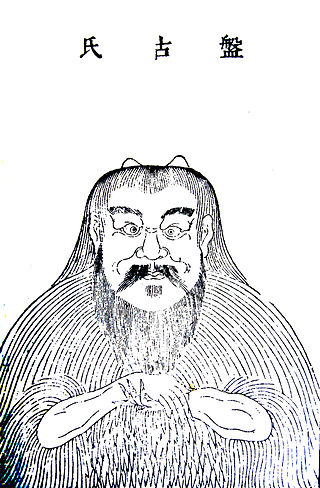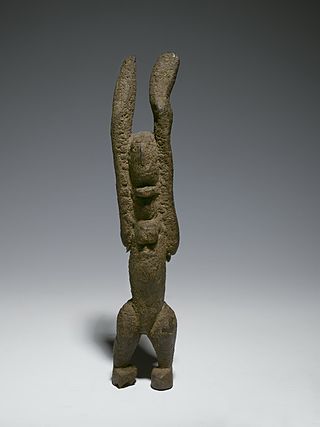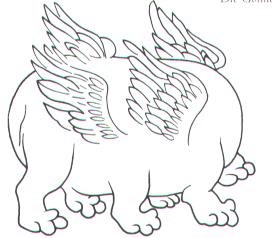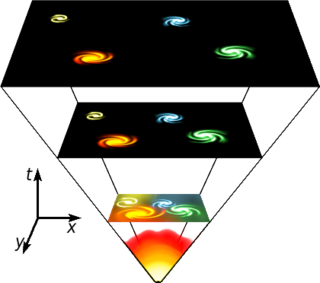
Flat Earth is an archaic and scientifically disproven conception of the Earth's shape as a plane or disk. Many ancient cultures subscribed to a flat-Earth cosmography, notably including ancient near eastern cosmology. The model has undergone a recent resurgence as a conspiracy theory.

The cosmos is an alternative name for the universe or its nature or order. Usage of the word cosmos implies viewing the universe as a complex and orderly system or entity.

Cosmogony is any model concerning the origin of the cosmos or the universe.

Nu or Nun, in ancient Egyptian religion, is the personification of the primordial watery abyss which existed at the time of creation and from which the creator sun god Ra arose.

Biblical cosmology is the account of the universe and its laws in the Bible. The Bible was formed over many centuries, involving many authors, and reflects shifting patterns of religious belief; consequently, its cosmology is not always consistent. Nor do the biblical texts necessarily represent the beliefs of all Jews or Christians at the time they were put into writing: the majority of the texts making up the Hebrew Bible or Old Testament in particular represent the beliefs of only a small segment of the ancient Israelite community, the members of a late Judean religious tradition centered in Jerusalem and devoted to the exclusive worship of Yahweh.

Pangu is a primordial being and creation figure in Chinese mythology and Taoism. According to the legend, Pangu separated heaven and earth, and his body later became geographic features such as mountains and roaring water.

The Nommo or Nummo are primordial ancestral spirits in Dogon religion and cosmogony venerated by the Dogon people of Mali. The word Nommos is derived from a Dogon word meaning "to make one drink." Nommos are usually described as amphibious, hermaphroditic, fish-like creatures. Folk art depictions of Nommos show creatures with humanoid upper torsos, legs/feet, and a fish-like lower torso and tail. Nommos are also referred to as "Masters of the Water", "the Monitors", and "the Teachers". Nommo can be a proper name of an individual or can refer to the group of spirits as a whole. For purposes of this article, "Nommo" refers to a specific individual and "Nommos" is used to reference the group of beings.

Hundun is both a "legendary faceless being" in Chinese mythology and the "primordial and central chaos" in Chinese cosmogony, comparable with the world egg.

Religious cosmology is an explanation of the origin, evolution, and eventual fate of the universe from a religious perspective. This may include beliefs on origin in the form of a creation myth, subsequent evolution, current organizational form and nature, and eventual fate or destiny. There are various traditions in religion or religious mythology asserting how and why everything is the way it is and the significance of it all. Religious cosmologies describe the spatial lay-out of the universe in terms of the world in which people typically dwell as well as other dimensions, such as the seven dimensions of religion; these are ritual, experiential and emotional, narrative and mythical, doctrinal, ethical, social, and material.

Creatio ex nihilo is the doctrine that matter is not eternal but had to be created by some divine creative act. It is a theistic answer to the question of how the universe came to exist. It is in contrast to creation ex materia, sometimes framed in terms of Parmenides' dictum Ex nihilo nihil fit or "nothing comes from nothing", meaning all things were formed ex materia.

Cosmology is a branch of physics and metaphysics dealing with the nature of the universe, the cosmos. The term cosmology was first used in English in 1656 in Thomas Blount's Glossographia, and in 1731 taken up in Latin by German philosopher Christian Wolff, in Cosmologia Generalis. Religious or mythological cosmology is a body of beliefs based on mythological, religious, and esoteric literature and traditions of creation myths and eschatology. In the science of astronomy, cosmology is concerned with the study of the chronology of the universe.

In ancient near eastern cosmology, the firmament signified a cosmic barrier that separated the heavenly waters above from the Earth below. In biblical cosmology, the firmament is the vast solid dome created by God during the Genesis creation narrative to divide the primal sea into upper and lower portions so that the dry land could appear.

The history of the Big Bang theory began with the Big Bang's development from observations and theoretical considerations. Much of the theoretical work in cosmology now involves extensions and refinements to the basic Big Bang model. The theory itself was originally formalised by Father Georges Lemaître in 1927. Hubble's Law of the expansion of the universe provided foundational support for the theory.
Chinese creation myths are symbolic narratives about the origins of the universe, earth, and life. Myths in China vary from culture to culture. In Chinese mythology, the term "cosmogonic myth" or "origin myth" is more accurate than "creation myth", since very few stories involve a creator deity or divine will. Chinese creation myths fundamentally differ from monotheistic traditions with one authorized version, such as the Judeo-Christian Genesis creation narrative: Chinese classics record numerous and contradictory origin myths. Traditionally, the world was created on Chinese New Year and the animals, people, and many deities were created during its 15 days.

A cosmic ocean, primordial waters, or celestial river is a mythological motif that represents the world or cosmos enveloped by a vast primordial ocean. Found in many cultures and civilizations, the cosmic ocean exists before the creation of the Earth. From the primordial waters the Earth and the entire cosmos arose. The cosmic ocean represents or embodies chaos.
Zoroastrian or Iranian cosmology refers to the origins (cosmogony) and structure (cosmography) of the cosmos in Zoroastrianism. Zoroastrian literature describing cosmographical beliefs include the Avesta and, in later Middle Persian literature, texts including the Bundahishn, Denkard, and the Wizidagiha-i Zadspram.
The Serer creation myth is the traditional creation myth of the Serer people of Senegal, the Gambia and Mauritania. Many Serers who adhere to the tenets of the Serer religion believe these narratives to be sacred. Some aspects of Serer religious and Ndut traditions are included in the narratives contained herein but are not limited to them.
The Lebe or Lewe is a Dogon religious, secret institution and primordial ancestor, who arose from a serpent. According to Dogon cosmogony, Lebe is the reincarnation of the first Dogon ancestor who, resurrected in the form of a snake, guided the Dogons from the Mandé to the cliff of Bandiagara where they are found today.
Amma is an African tribal deity – the supreme creator god in the Dogon religion. The Dogon story of the creation of the world relates that the sky god Amma mated with the earth goddess, and because Amma was prevented from joining the goddess's clitoris in the form of a giant termite mound, he produced only an imperfect offspring – a desert fox or jackal – and therefore eventually removed the termite mound. Leaving the earth, he instituted the religious ritual of female circumcision. After removing the termite mound, the god Amma with the earth goddess continued procreating and begat humans. Duality is central to Dogon religion, the heavenly forces also have a dual character: the supreme god Amma has androgynous characteristics. The birth of twins is celebrated among the Dogon with a special religious ritual, as twins refer to the original dual structure of creation and to the harmony between earthly and heavenly.

Ancient near eastern (ANE) cosmology refers to the plurality of cosmological beliefs in the Ancient Near East covering the 4th millennium BC to the formation of the Macedonian Empire by Alexander the Great in the second half of the 1st millennium BC. This system of cosmology went on to have a profound influence on views in early Greek cosmology, later Jewish cosmology, patristic cosmology, and Islamic cosmology. Until the modern era, variations of ancient near eastern cosmology survived with Hellenistic cosmology as the main competing system.
















